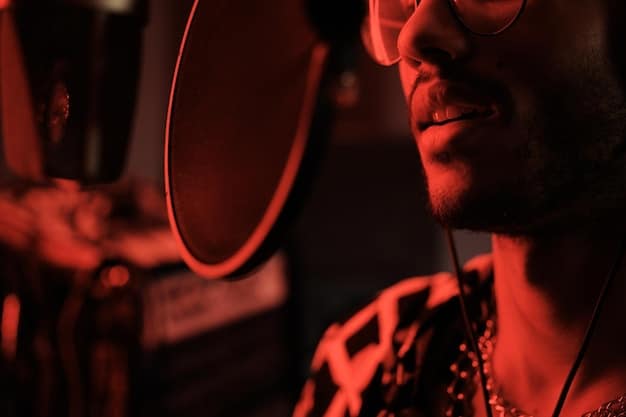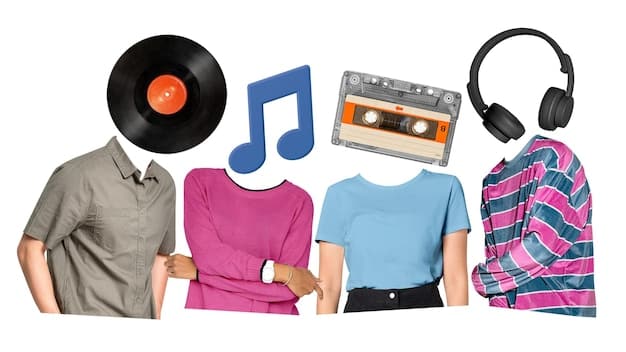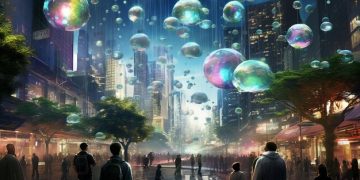The Future of Shonen Anime Soundtracks: Composers to Watch in 2025

Shonen anime soundtracks in 2025 will likely be shaped by both established composers and rising stars, blending traditional orchestral scores with modern electronic and rock elements to enhance the action and emotion of the genre.
The exhilarating world of shonen anime is not just about captivating storylines and dynamic animation; it’s also significantly shaped by its memorable soundtracks. As we look ahead to 2025, the question on every anime fan’s mind is: which composers will be setting the tone for the next generation of action-packed adventures? We’re diving deep into the scene to spotlight the artists behind the music, exploring how they’re innovating and what trends are influencing the future of shonen anime soundtracks: Which composers are shaping the sound of action anime in 2025?
Exploring the Evolution of Shonen Anime Music
Shonen anime music has come a long way since the early days of the genre. Initially, soundtracks were primarily orchestral, providing a grand and epic feel to the stories. Over time, rock and pop elements began to seep in, reflecting the changing tastes of audiences and the desire for music that could amplify the energy of fight scenes and pivotal moments.
Today, the landscape is even more diverse, with electronic music, hip-hop influences, and even traditional Japanese instruments finding their way into shonen anime scores. This evolution reflects not only the changing musical landscape but also the growing sophistication of anime storytelling, with soundtracks now playing a crucial role in enhancing emotional depth and character development.

Key Influences on Modern Shonen Soundtracks
Several factors are driving the evolution of shonen anime soundtracks. The globalization of anime has led to a cross-pollination of musical ideas, with composers drawing inspiration from a wide range of genres and cultures. Advances in music technology have also played a significant role, allowing composers to create more complex and dynamic scores using digital tools and virtual instruments.
Moreover, the increasing importance of music in anime marketing has led to greater investment in soundtracks, with studios recognizing the power of a memorable theme song or score to draw in viewers and create a lasting connection with the series.
- Globalization: Fusion of diverse musical styles from around the world.
- Technology: Advanced digital tools enabling complex and dynamic scores.
- Marketing: Increased investment in soundtracks for audience engagement.
In conclusion, the evolution of shonen anime music is a dynamic process driven by globalization, technological advancements, and marketing strategies, resulting in diverse and engaging soundtracks.
Spotlight on Current Leading Composers
Before we gaze into our crystal ball, it’s essential to acknowledge the titans who currently dominate the shonen anime music scene. These composers have set a high bar, consistently delivering scores that amplify the emotional and action-packed moments of the series they work on. They possess a deep understanding of storytelling and character development, translating these elements into unforgettable musical experiences.
These composers are the benchmarks against which emerging talents will be measured. Their innovative approaches and dedication to their craft have not only enriched the anime we love but also paved the way for future generations of musicians to explore the boundless possibilities of shonen anime soundtracks.
Hiroyuki Sawano: The Orchestral Rock Maestro
Hiroyuki Sawano is a name synonymous with epic anime scores. Known for his work on series like “Attack on Titan,” “Kill la Kill,” and “Mobile Suit Gundam Unicorn,” Sawano seamlessly blends orchestral arrangements with rock and electronic elements, creating a sound that is both grand and intensely energetic.
His distinctive style often features powerful vocals and soaring melodies, enhancing the emotional impact of key scenes and battles. Sawano’s influence on modern anime music is undeniable, and his innovative approach has inspired countless composers.
Yuki Kajiura: The Queen of Atmospheric Soundscapes
Yuki Kajiura is another prominent figure in the anime music world, renowned for her work on series like “Puella Magi Madoka Magica,” “Fate/Zero,” and “.hack//Sign.” Kajiura’s compositions are characterized by their haunting melodies, ethereal vocals, and intricate arrangements, creating atmospheric soundscapes that perfectly complement the tone and themes of the series she works on.
Her music often blurs the lines between classical, electronic, and world music, resulting in a unique and captivating listening experience. Kajiura’s ability to evoke a wide range of emotions through her music has earned her a dedicated following and critical acclaim.
- Hiroyuki Sawano: Orchestral rock fusion for epic anime scores.
- Yuki Kajiura: Atmospheric soundscapes with haunting melodies.
In summary, Hiroyuki Sawano and Yuki Kajiura exemplify outstanding contributions to shonen anime soundtracks, shaping modern anime and inspiring composers through innovation and dedication.
Emerging Composers to Watch
Looking ahead to 2025, several emerging composers are poised to make a significant impact on the shonen anime music scene. These up-and-coming talents bring fresh perspectives, innovative ideas, and a willingness to experiment, pushing the boundaries of what’s possible in anime soundtracks.
Their diverse musical backgrounds and unique approaches promise to inject new energy and excitement into the genre, ensuring that shonen anime music remains as dynamic and captivating as ever. Keep an eye on these rising stars as they continue to shape the future of anime soundtracks.

Asami Tachibana: The Emotional Storyteller
Asami Tachibana has quickly gained recognition for her emotionally resonant scores in series like “Haikyu!!” and “DARLING in the FRANXX.” Her music is characterized by its delicate melodies, heartfelt harmonies, and subtle use of electronic elements, creating a sound that is both intimate and emotionally powerful.
Tachibana’s ability to connect with the emotional core of a story and translate it into music has made her a sought-after composer in the anime industry. Her work showcases a deep understanding of character development and storytelling, making her a rising star to watch.
Kevin Penkin: The Global Innovator
Kevin Penkin is an Australian composer who has made a name for himself in the anime world with his work on series like “Made in Abyss” and “The Rising of the Shield Hero.” Penkin’s music is characterized by its eclectic blend of orchestral, electronic, and world music elements, creating a sound that is both unique and globally inspired.
His willingness to experiment and push the boundaries of traditional anime scores has earned him critical acclaim and a dedicated following. Penkin’s international background and diverse musical influences make him a true innovator in the genre.
- Asami Tachibana: Emotional resonance through delicate melodies and harmonies.
- Kevin Penkin: Eclectic blend of global musical elements.
In essence, Asami Tachibana and Kevin Penkin represent emerging composers to watch, bringing emotional depth and global innovation to shonen anime soundtracks.
Technological Innovations and Their Impact
The integration of technology has revolutionized the way music is composed, produced, and experienced. From digital audio workstations (DAWs) to virtual instruments and AI-assisted composition tools, technology has empowered composers to create more complex, dynamic, and personalized soundtracks than ever before.
These innovations not only enhance the creative process but also enable composers to reach wider audiences through streaming platforms, social media, and interactive experiences. As technology continues to evolve, its impact on shonen anime music will only become more profound, paving the way for new sonic landscapes and immersive storytelling techniques.
AI-Assisted Composition: A New Frontier
Artificial intelligence (AI) is rapidly transforming various aspects of the music industry, and anime soundtracks are no exception. AI-assisted composition tools can help composers generate melodies, harmonies, and rhythms, providing a starting point for their creative process. While AI is unlikely to replace human composers entirely, it can serve as a valuable tool for inspiration and experimentation.
These tools can also analyze existing anime soundtracks to identify patterns and trends, helping composers create music that resonates with audiences while still maintaining its originality. As AI technology continues to improve, its role in shonen anime music is likely to grow, opening up new possibilities for innovation and collaboration.
Virtual Instruments and Orchestras: Expanding Sonic Palettes
Virtual instruments and orchestras have become essential tools for modern anime composers, allowing them to create realistic and expressive orchestral arrangements without the need for live musicians. These digital instruments offer a vast range of sounds, from traditional strings and brass to exotic percussion and synthesized textures, expanding the sonic palettes available to composers.
Virtual instruments also make it easier for composers to experiment with different arrangements and orchestrations, allowing them to fine-tune their scores to perfection. As technology advances, virtual instruments will only become more realistic and versatile, further empowering composers to create stunning anime soundtracks.
In conclusion, technological advancements are transforming shonen anime scores through AI-assisted composition and virtual instruments, boosting both experimentation and sonic diversity.
The Influence of Gaming and Interactive Media
The convergence of anime, gaming, and interactive media is creating new opportunities for composers to explore innovative storytelling techniques and engage with audiences in more immersive ways. Anime-inspired video games often feature elaborate soundtracks that complement the gameplay and enhance the emotional impact of the narrative. Similarly, interactive media experiences like virtual reality (VR) and augmented reality (AR) offer composers the chance to create dynamic and responsive scores that react to the user’s actions and choices.
These interactive experiences are blurring the lines between passive viewing and active participation, opening up new avenues for creativity and audience engagement. As anime continues to expand into these interactive spaces, its music will play an increasingly important role in shaping the overall experience.
Interactive Soundtracks: Music That Responds to You
Interactive soundtracks are a growing trend in gaming and interactive media, offering a dynamic and personalized listening experience. These soundtracks are designed to respond to the user’s actions, choices, and emotions, creating a sense of immersion and engagement that traditional soundtracks cannot replicate.
For example, the music might change based on the player’s location, the time of day, or the intensity of the action. Interactive soundtracks can also be used to provide feedback to the player, signaling danger, reward, or progress. As technology advances, interactive soundtracks will become more sophisticated and responsive, further blurring the lines between music and gameplay.
Anime-Inspired Gaming Soundtracks: A Growing Market
Anime-inspired video games are a rapidly growing market, and their soundtracks are playing an increasingly important role in defining the overall experience. These soundtracks often feature original compositions that capture the style and tone of the anime series they are based on, as well as licensed music from popular anime artists.
Anime-inspired gaming soundtracks can also serve as a gateway for new listeners to discover anime music, further expanding the reach and influence of the genre. As the anime gaming market continues to grow, its soundtracks will become an increasingly important part of the anime music landscape.
To summarize, the intertwining of gaming and anime music enhances immersive storytelling, offering interactive soundtracks that cater to player actions and expand the anime music market.
Predictions for Shonen Anime Soundtracks in 2025
As we look ahead to 2025, it’s clear that shonen anime soundtracks will continue to evolve in exciting and unexpected ways. The fusion of traditional and modern elements, the integration of technology, and the influence of gaming and interactive media will all play a significant role in shaping the future of anime music.
Composers will continue to push the boundaries of creativity, experimenting with new sounds, styles, and techniques to create soundtracks that are both memorable and emotionally resonant. By embracing innovation and collaboration, they will ensure that shonen anime music remains a vital and dynamic force in the world of entertainment.
Greater Emphasis on Emotional Depth
In 2025, we can expect to see a greater emphasis on emotional depth in shonen anime soundtracks. Composers will strive to create music that not only enhances the action and excitement of the series but also delves into the emotional complexities of the characters and their stories.
This might involve using more nuanced instrumentation, intricate harmonies, and introspective themes to evoke a wider range of emotions in the audience. By prioritizing emotional depth, composers can create soundtracks that resonate with listeners on a deeper level, forging a stronger connection between the music and the anime series.
More Integration of Global Musical Styles
The globalization of anime will continue to drive the integration of global musical styles in shonen anime soundtracks. Composers will draw inspiration from a wider range of cultures and musical traditions, incorporating elements of world music, folk music, and experimental music into their scores.
This might involve using traditional instruments from different countries, sampling ethnic rhythms and melodies, or collaborating with musicians from diverse backgrounds. By embracing global musical styles, composers can create soundtracks that are both unique and universally appealing, reflecting the increasingly interconnected nature of the world.
- Emotional Depth: Increased focus on nuanced instrumentation and themes.
- Global Styles: Integration of diverse cultural and musical traditions.
In short, predictions for shonen anime scores in 2025 indicate enhanced emotional depth and the embracing of varied global musical styles.
| Key Point | Brief Description |
|---|---|
| 🎵Evolving Music | Shonen anime music evolves with orchestral, rock, electronic influences. |
| 🌟Leading Composers | Sawano & Kajiura set benchmarks with orchestral rock and atmospheric soundscapes. |
| 🚀Emerging Talents | Tachibana & Penkin bring emotionally resonant and global sounds. |
| 🤖Tech Influence | AI & virtual instruments boost innovation and sonic variety. |
Frequently Asked Questions
▼
A shonen anime soundtrack typically features high-energy music, often blending orchestral scores with rock or electronic elements to enhance action scenes. It also includes emotional pieces to deepen character development and storytelling.
▼
Influential composers include Hiroyuki Sawano, known for “Attack on Titan,” and Yuki Kajiura, recognized for “Puella Magi Madoka Magica.” Both have significantly shaped modern anime music with their unique styles.
▼
Technology has enabled composers to create complex scores using digital tools and virtual instruments. AI-assisted composition is also emerging, offering new possibilities for innovation in anime music.
▼
Anime-inspired video games feature soundtracks that complement gameplay, often including original compositions and licensed music. Interactive soundtracks enhance immersion, responding dynamically to player actions.
▼
Future trends include a greater emphasis on emotional depth and the integration of global musical styles. Composers will continue to push boundaries, experimenting with new sounds to resonate with audiences.
Conclusion
As we journey toward 2025, the realm of shonen anime soundtracks promises to be a thrilling blend of innovation and tradition. With emerging composers pushing boundaries and technology offering new creative avenues, the future of anime music looks set to deliver even more immersive and emotionally resonant experiences for fans worldwide. Keep an ear out for these rising stars and evolving sounds that are shaping the future of shonen anime.





